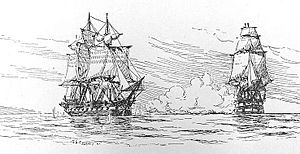Chesapeake–Leopard Affair facts for kids
Quick facts for kids Chesapeake–Leopard Affair |
|||||||
|---|---|---|---|---|---|---|---|
| Part of the events leading to the War of 1812 | |||||||
 HMS Leopard (right) fires upon the USS Chesapeake |
|||||||
|
|||||||
| Belligerents | |||||||
| Commanders and leaders | |||||||
| Strength | |||||||
| 1 4th rate | 1 frigate | ||||||
| Casualties and losses | |||||||
| none | 1 frigate damaged 4 killed 17 wounded 4 captured |
||||||
The Chesapeake–Leopard Affair was an important event that happened at sea on June 22, 1807. It took place near Norfolk, Virginia. A British warship, the HMS Leopard, attacked an American ship, the USS Chesapeake. The British were searching for sailors who had left their navy. The American commander had to surrender his ship. Later, he faced serious consequences and left the military.
Contents
What Was the Chesapeake–Leopard Affair?
The Chesapeake–Leopard Affair was a naval incident. It happened between the British Royal Navy and the United States Navy. This event was a major cause of anger between the two countries. It helped lead to the War of 1812.
Why Did It Happen?
At this time, Great Britain was fighting a big war in Europe. They needed many sailors for their ships. Sometimes, British sailors would leave their ships and join American merchant ships. The British called these sailors "deserters."
The British navy had a practice called "impressment." This meant they could stop American ships. They would then search for and force British sailors to join their navy. They often took American sailors too, claiming they were British.
What Happened on June 22, 1807?
On June 22, 1807, the British warship HMS Leopard found the American frigate USS Chesapeake. The Chesapeake was leaving Norfolk, Virginia. The British commander, Salusbury Pryce Humphreys, demanded to search the American ship. He believed there were British deserters on board.
The American commander, James Barron, refused the search. He said his ship was a warship, not a merchant vessel. British ships were not supposed to search warships from other countries.
The Attack
Because Barron refused, the Leopard opened fire on the Chesapeake. The American ship was not ready for battle. Its cannons were not prepared. After about 15 minutes, the Chesapeake was badly damaged. Four American sailors were killed, and 17 were wounded.
Commander Barron had to surrender his ship. British officers then boarded the Chesapeake. They took four sailors they claimed were British deserters. Only one of these sailors was actually British. The other three were American citizens.
What Was the Impact?
The attack on the Chesapeake made many Americans very angry. People across the country called for war against Great Britain. It was seen as a major insult to American pride and independence.
President Thomas Jefferson tried to solve the problem peacefully. He used diplomacy to pressure the British government. However, British diplomats did not think they had done anything wrong. They also said they would continue impressment.
Jefferson's efforts to find a diplomatic solution failed. This led him to try a different approach. He pushed for an economic embargo. This law stopped all American trade with other countries. The goal was to hurt Britain's economy. However, the embargo also hurt the American economy.
The Chesapeake–Leopard Affair was a key event. It showed the growing tension between the United States and Great Britain. It was one of the important reasons that led to the War of 1812 a few years later.
Images for kids
-
USS Chesapeake, depicted in a c. 1900 painting by F. Muller




